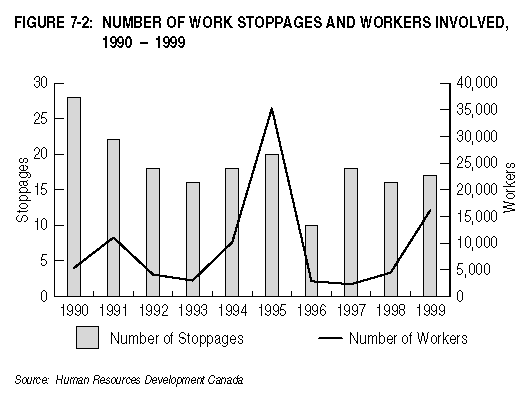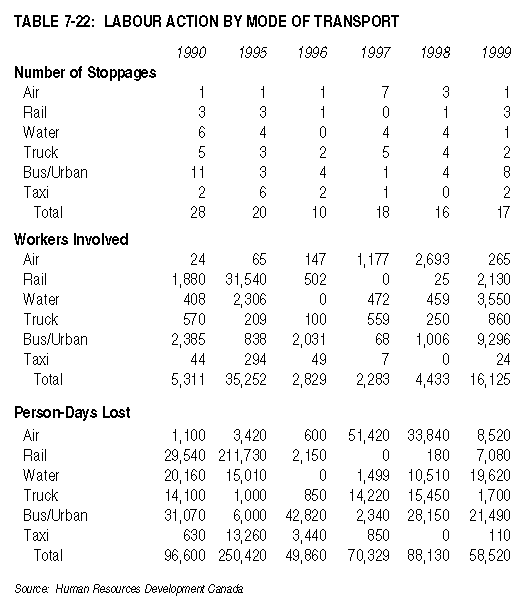7
TRANSPORTATION AND
EMPLOYMENT
Labour Action in TransportationNote 34
Number of Work Stoppages
There were 17 labour stoppages recorded in 1999. Eight of these
represented labour action in the bus and urban transit sector.
There were three stoppages recorded in the rail sector during
the fourth quarter of 1999. Air and water transport with one stoppage
each, and truck and taxi, with two stoppages each, accounted for
the remaining 33 per cent of labour action in the industry.
Overall, Canada has enjoyed a relatively stable labour environment
in the transportation industry over the last decade. Between 1990
and 1998, labour stoppages fluctuated between a high of 28 in
1990 and a low of ten in 1996, averaging 18 stoppages
per year over the period. The bus and urban transit sector contributed
significantly to the higher numbers recorded in 1990 and 1991,
and to the overall average.
Number of Workers Involved
The number of workers involved in labour stoppages fluctuated
between 2,300 and 35,000 between 1990 and 1998, averaging 8,700
per year over the period. While 1990 had the largest number of
stoppages, the number of workers involved (5,311) was significantly
below the annual average. The number of workers involved in work
stoppages peaked in 1995 at 35,252; labour action in the rail
sector accounted for 89 per cent of this total.
There were over 16,000 workers involved in stoppages in 1999.
The bus and urban transit sector accounted for 58 per cent
of this number; water and rail transport accounted, respectively,
for 22 per cent and 13 per cent; and air, truck and taxi
made up the remaining seven per cent.
Figure 7-2 shows the number of stoppages and workers involved
in labour stoppages in the transportation industry over the last
decade.

Person-Days Lost
The number of person-days lost due to labour stoppages averaged
112,000 between 1990 and 1998, with a peak of 250,000 in 1995.
Rail, with three stoppages that year, accounted for 85 per cent
of all person-days lost. The lowest number of losses occurred
in 1996 (49,860), with the bus and urban transit sector accounting
for 86 per cent of that total.
Over 58,000 person-days were lost due to labour action in 1999.
The one labour stoppage in the water transport sector at the Port
of Vancouver during the fourth quarter of 1999 was the most significant
one in transportation, accounting for over 33 per cent of total
person-days lost in transportation in 1999. However the eight
stoppages in the bus and urban transit sector accounted for an
additional 37 per cent of that number. Work stoppages
in the air and rail sector, respectively, accounted for 15 and
12 per cent of person-days lost. Losses in the truck and taxi
sectors were negligible in 1999, accounting for only three per
cent of transport's person-days lost.
Ontario was, after British Columbia, the most affected province
by labour action with 20,030 person-days lost during 1999.Note
35 Nova Scotia lost 8,500 person-days in 1998 due to urban
transit labour action, and British Columbia lost 2,660 person-days
in 1999 to similar problems. Newfoundland accounted for 8,520
person-days lost in 1999 due to a labour stoppage in the air transportation
sector.
Figure 7-3 compares the number of work stoppages and the
associated number of person-days lost in the transportation industry
over the last decade.

Table 7-22 summarizes the number of stoppages, workers involved
and person-days lost due to labour action in the transportation
industry since 1990.

Labour Action in Transportation
|

